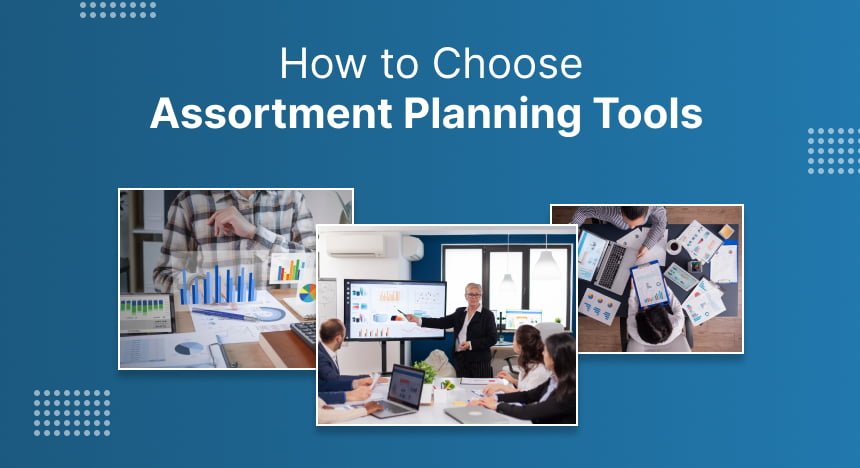Tired of guessing products that will sell well?
Do you struggle with stockouts or overstocking?
Want to streamline your inventory management process?
If the answer to any of the above situations is “YES”, it’s time to consider investing in assortment planning tools. These innovative solutions deliver better analytics so you can make decisions about assortment range. Using them you can ensure that you have the right mix of items in stock at the right time.
But with so many options available, how do you choose the best tool for your business? Don’t worry, we’ve got you covered!
How To Choose The Right Assortment Planning Tools/ Software?
Assortment planning in retail is a pivotal aspect of making a profitable retail business. However, having the right tool at your disposal is equally important.
Choosing the right assortment planning tool can be overwhelming, especially with a plethora of options available. Therefore, we have outlined some handy tips to help you choose the right solution.
1. Define Your Needs
Before starting your search, it’s essential to understand your requirements. Consider the following factors to choose an assortment planning solution:
- Business size and complexity
- Product Categories and SKUs
- Sales channels (online, offline, or both)
- Existing systems and integrations
- Budget
2. Types of Assortment Planning Tools
Assortment planning tools can be broadly classified into three categories:
Spreadsheet-based Tools
These are basic tools that use spreadsheets to manage product data and perform calculations. They are suitable for small businesses with simple assortment needs.
Specialized Assortment Planning Software
These tools are designed specifically for retailers and offer advanced features such as automated recommendations, analytics, and reporting. They are ideal for medium to large businesses with complex assortment needs. One reliable tool under this category is REPLAN- It’s a complete retail planning solution.
ERP Systems
Enterprise Resource Planning (ERP) systems are comprehensive solutions that manage all aspects of a business, including assortment planning. They are best suited for large enterprises with multiple departments and locations.
3. Features to Look For in Assortment Planning Tools/ Software
When evaluating assortment planning tools, consider the following features:
- Data Management: The tool should allow you to easily import, export, and manipulate product data. It should also provide real-time updates and insights into inventory levels, sales trends, and customer preferences.
- Automated Recommendations: The tool should provide intelligent recommendations based on historical sales data, seasonality, and industry trends. This feature helps you make informed decisions about which products to stock, eliminate, or promote.
- Analytics and Reporting: It must offer robust analytics and reporting capabilities, enabling you to track performance by category, brand, and individual product. This information helps you identify areas of improvement and optimize your assortment strategy.
- Integration with Other Systems: It should integrate seamlessly with your existing systems, such as point-of-sale (POS), e-commerce platform, and inventory management system. This integration ensures accurate data flow and eliminates manual errors.
- User Interface and Experience: The tool should have an intuitive user interface, so you can use it without any hassle. A user-friendly interface reduces training time and increases adoption rates among team members.
- Additional Features: In addition to assortment planning, the solution must have other required features like merchandise planning and allocation, replenishment, and others.
4. Implementation and Support
Implementing a new assortment planning tool can be challenging, especially for larger organizations. Ensure that the vendor provides adequate support throughout the implementation process, including training, documentation, and technical assistance.
5. Pricing and ROI
The cost of tools varies widely depending on the vendor, functionality, and scalability. Calculate the return on investment (ROI) by considering increased efficiency, improved forecasting accuracy, and reduced waste. Compare these benefits with the total cost of ownership (TCO), including licensing fees, implementation costs, and maintenance expenses.
6. Vendor Selection
Evaluate vendors based on their reputation, experience, and customer service. Research online reviews, case studies, and testimonials to gauge customer satisfaction. Also, look for vendors who offer demos, trials, or pilots to test their tools before committing to a purchase.
Conclusion
Choosing the appropriate assortment planning tool is crucial for optimizing your product mix, improving customer satisfaction, and increasing revenue. By using the tips below, you can find the perfect tool for your retail planning. With the right tool, you’ll be able to create a compelling product offering that sets your business apart from the competition.



